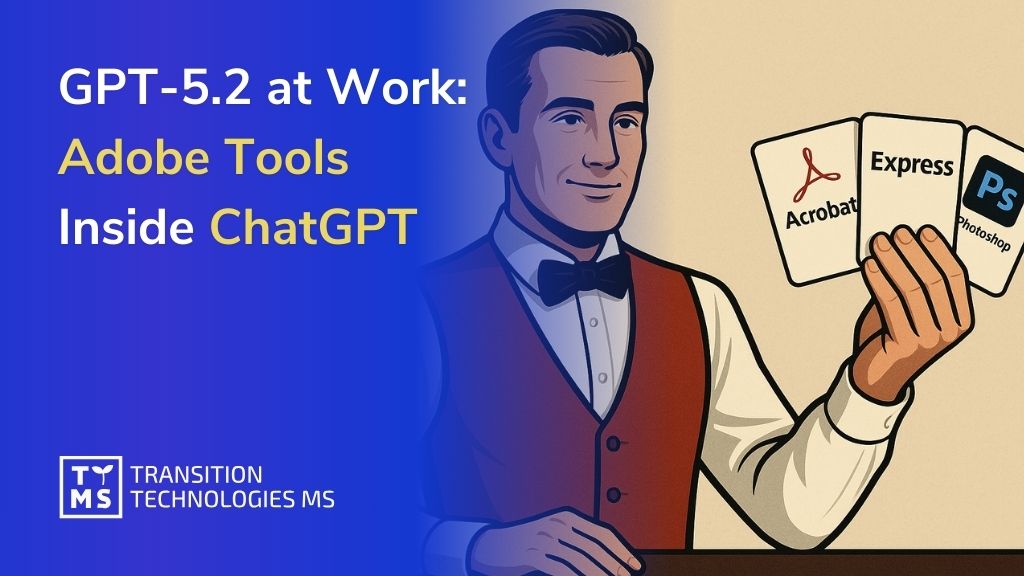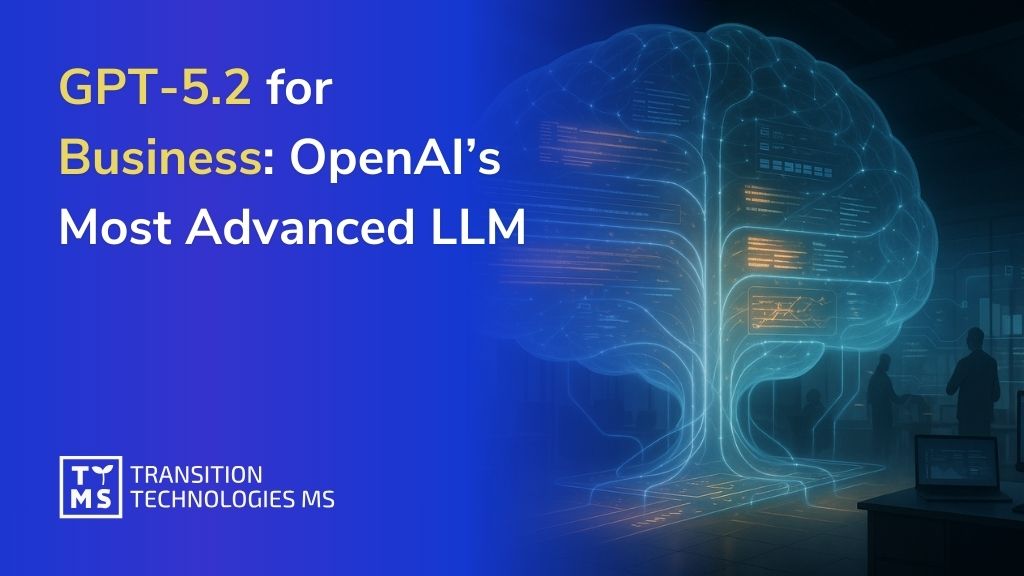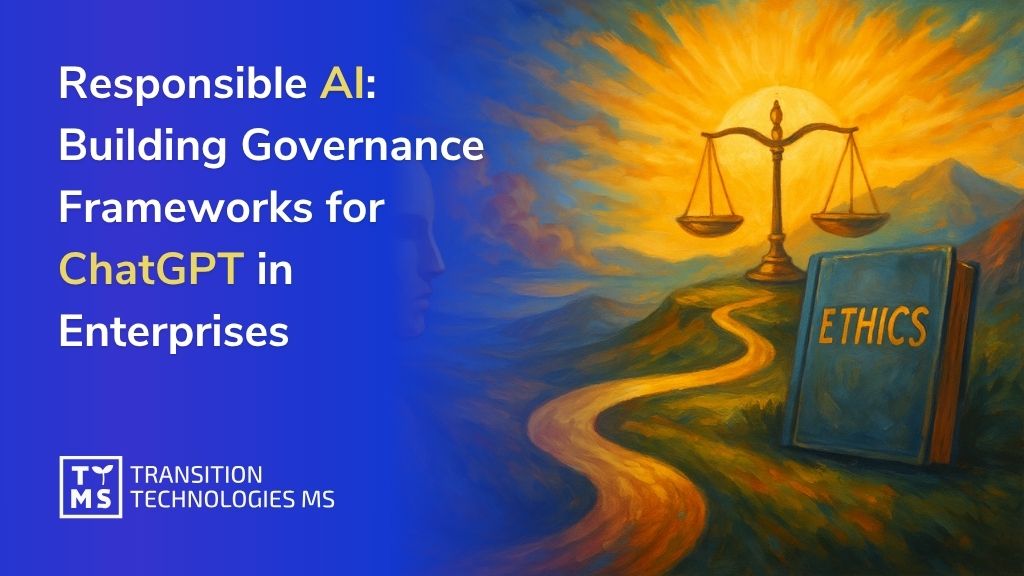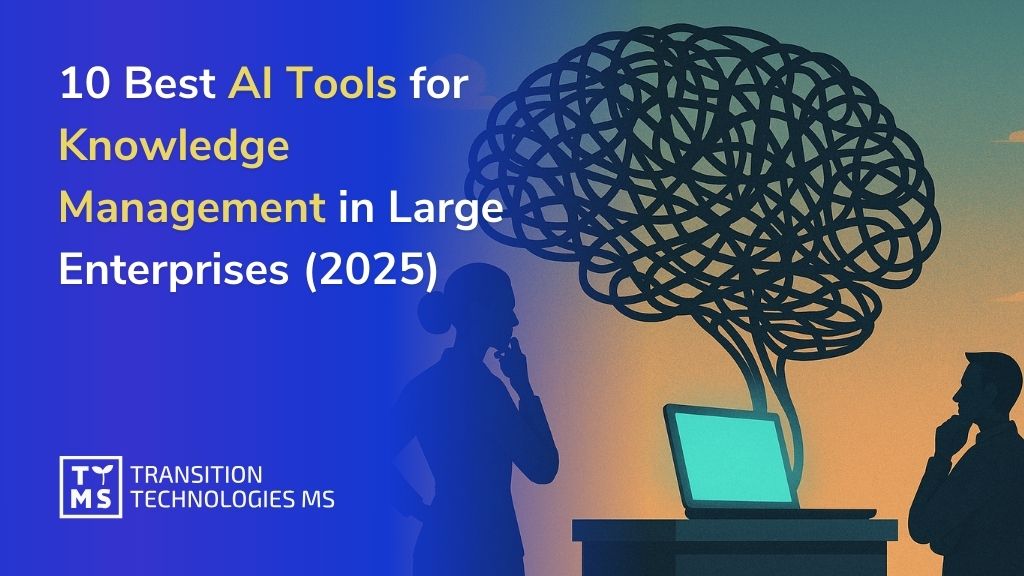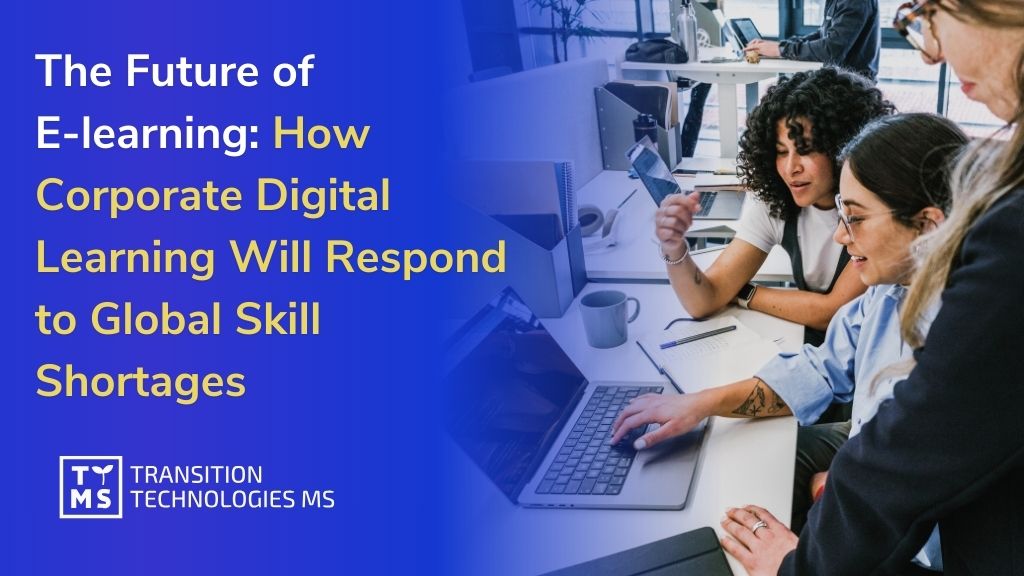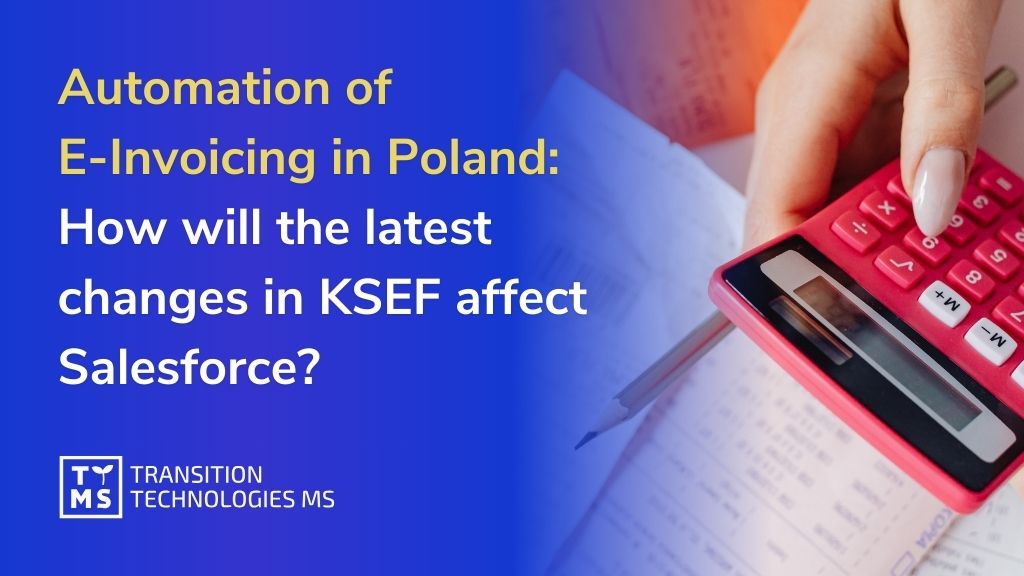Imagine if you could delegate your most tedious business tasks to an intelligent assistant that works 24/7, never makes a mistake, and only gets smarter with time. This is the promise of artificial intelligence (AI) in business automation – and it’s no longer science fiction. Companies are rapidly adopting AI to streamline operations and boost productivity by up to 40%. In fact, 83% of firms now rank AI as a top strategic priority for their future plans. From customer service chatbots that handle millions of inquiries to algorithms that predict market trends in seconds, AI is transforming how business gets done.
1. Introduction to AI-Powered Business Automation
The global surge in AI adoption is reshaping the business landscape. With AI algorithms capable of learning and improving autonomously, businesses are leveraging these technologies to automate routine processes, reduce errors, and accelerate decision-making. Crucially, AI-driven automation isn’t about replacing humans – it’s about freeing your workforce from repetitive, low-value tasks so they can focus on creativity, strategy, and innovation.
AI vs. Traditional Automation: Unlike classic rule-based software, AI systems can handle complexity and uncertainty. They use techniques like machine learning and natural language processing to adapt to new data and scenarios. This means AI automation can tackle tasks that historically required human judgment – from interpreting customer emails to spotting anomalies in financial transactions. The result is a more resilient and intelligent automation that can evolve with your business needs.
Why Now? Several factors have converged to make AI automation essential today. Data volumes have exploded, far beyond what humans alone can analyze. Computing power is cheaper and more accessible (think cloud services), enabling even smaller companies to deploy AI. And importantly, the competitive bar is rising: companies that successfully implement AI are reaping significant rewards, such as faster growth and higher efficiency, leaving others at risk of falling behind. As one survey noted, 82% of business leaders expect AI to disrupt their industry within 5 years – and most feel “excited, optimistic, and motivated” by this AI-driven future. In short, embracing AI for automation is no longer just an option; it’s rapidly becoming a necessity for staying competitive.

2. Key Areas to Automate with AI in Your Business
AI can be applied to almost every department and process in a modern organization. Below, we explore the key areas where using AI to automate business processes can deliver the biggest impact, along with real examples and results.
2.1 Automate Marketing & Sales for Personalization and Growth
AI is revolutionizing marketing beyond basic email workflows. Modern AI-driven marketing tools analyze customer behavior and preferences to personalize content and offers at scale. This goes far beyond traditional automation – AI can predict what a customer is likely to want next and tailor campaigns accordingly. For example, e-commerce giants use AI to recommend products uniquely suited to each shopper, increasing conversion rates.
- Personalized Campaigns: AI can segment your audience and generate customized messages for each segment (or individual). This level of personalization pays off: companies implementing AI-based personalization have seen 10–30% higher conversion rates and up to 800% return on investment in marketing. AI analyzes what content or products resonate with users and adjusts in real time, leading to better engagement and sales.
- Dynamic Pricing & Sales Forecasting: AI algorithms help retailers and service providers set optimal prices by analyzing demand, competition, and customer trends. They can also forecast sales more accurately by processing myriad data points (seasonality, web traffic, social media sentiment, etc.), enabling proactive inventory and marketing adjustments.
- Lead Scoring and Follow-ups: In sales, AI tools automatically score leads based on their likelihood to convert, ensuring sales teams focus on the most promising opportunities. AI chatbots and virtual sales assistants can even engage website visitors, answer product questions, or schedule meetings with human reps, effectively automating the top-of-funnel interactions.
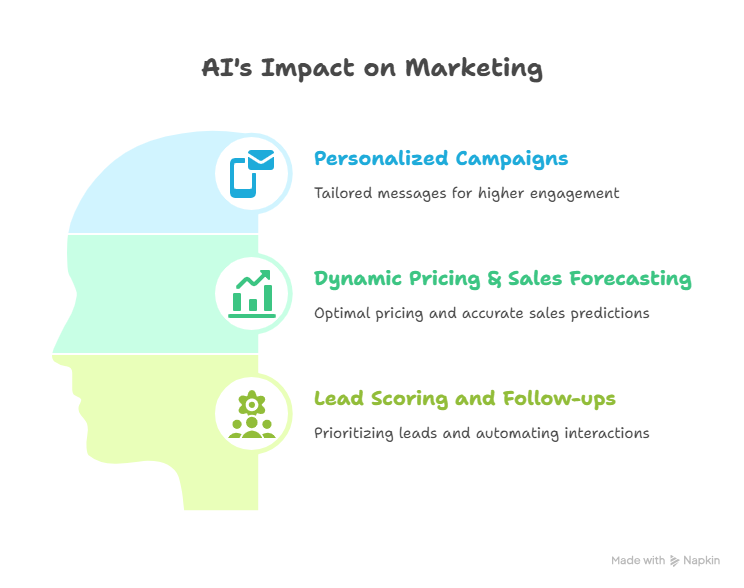
Real-world example: Hilton Hotels used AI to analyze staff scheduling (a form of internal marketing operations) and saw improved employee satisfaction that translated into better guest experiences. On the customer side, H&M’s AI chatbot assists online shoppers by answering questions and giving product recommendations, which not only boosts customer experience but also drives sales. These examples show that whether behind the scenes or customer-facing, AI brings a new level of efficiency and personalization to marketing and sales.
2.2 Enhance Customer Service with Intelligent AI Assistants
If your business handles customer inquiries or support tickets, AI can automate a large portion of this work while improving customer satisfaction. AI-powered chatbots and virtual agents are capable of understanding natural language questions and providing instant responses. They don’t take breaks, they don’t get frustrated, and they can handle thousands of queries simultaneously – something no human team can match.
- 24/7 Instant Support: Modern AI chatbots can resolve common issues (password resets, order status checks, FAQs, etc.) without human intervention. This dramatically reduces wait times for customers. It’s estimated that companies will save up to $11 billion in support costs and 2.5 billion hours of work by using chatbots. Moreover, these bots are available around the clock. For instance, an airline’s AI assistant can rebook your flight at 2 AM when a delay occurs, providing service when live agents might be unavailable.
- Higher Satisfaction at Lower Cost: Advanced AI assistants not only cut costs but also drive up satisfaction. They can handle routine tasks perfectly and escalate complex issues to human staff with full context. This hybrid approach means customers get fast answers to simple questions, and more thoughtful help on complex ones. No wonder 95% of companies adopting AI in customer service report improved customer satisfaction alongside cost savings. Even internally, support agents benefit: one study found agents using AI assistance handled nearly 14% more inquiries per hour.
- Personalized Service at Scale: AI can remember customer preferences and history, enabling a personalized touch. For example, a telecom company’s chatbot can greet a customer by name and proactively mention their specific plan details. If a bot has handled prior interactions, it can tailor its answers accordingly. Consistency and personalization together create a better experience.
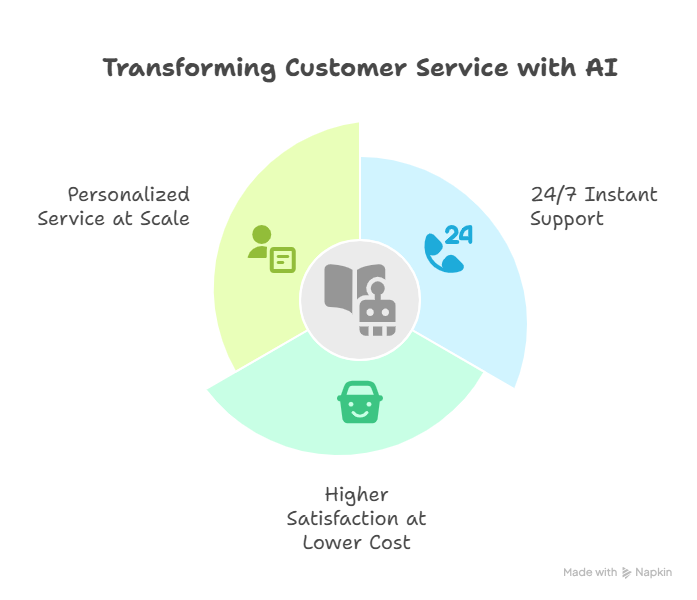
Real-world example: Banking giant HSBC uses voice-recognition AI for customer authentication in phone banking, speeding up identity verification and reducing fraud risk. Meanwhile, clothing retailer Zara employs AI chatbots on its website to instantly answer customer questions about sizing and stock, freeing up human reps for complex styling advice. Across industries, businesses report significant improvements – one survey showed HiverHQ’s clients saw a 20% uptick in customer satisfaction scores after introducing AI into support. In short, AI-driven customer service isn’t just faster and cheaper – it can genuinely enhance the support experience.
2.3 Streamline Operations and Supply Chain Management
Operations and supply chain management involve many repetitive and data-intensive tasks, from managing inventory levels to coordinating logistics. AI excels in these areas by analyzing large data sets in real time and automating decisions that keep things running smoothly:
- Inventory Management and Demand Forecasting: AI systems can analyze sales data, market trends, and even weather patterns to forecast demand with far greater accuracy than traditional methods. This means businesses can optimize stock levels – avoiding excess inventory on one hand and stockouts on the other. For example, Unilever’s AI-driven supply chain platform improved forecast accuracy from 67% to 92%, reducing excess inventory by €300 million while maintaining over 99% service levels. Likewise, Coca-Cola’s AI models cut forecasting errors by 30%, enabling a huge reduction in “just-in-case” inventory buffers.
- Automated Logistics and Routing: In logistics, AI finds the best routes and schedules in a way humans simply can’t. It accounts for traffic, fuel costs, delivery windows, and more – all in real time. Microsoft’s global logistics network uses AI to automate fulfillment planning, reducing what used to take planners 4 days of work into a 30-minute automated run (with 24% better accuracy to boot). Shipping companies like FedEx leverage AI to predict vehicle maintenance needs (preventing breakdowns) and to optimize delivery routes, saving millions in operational costs.
- Real-time Monitoring and Risk Response: AI-powered control towers monitor supply chain events as they happen. They can detect a disruption – say a port delay or a sudden spike in demand – and automatically reroute shipments or adjust production. Target’s supply chain AI, for instance, watches data from 1,900+ stores and cut out-of-stock situations by 40% by reacting immediately to inventory anomalies. Home Depot’s AI-driven demand sensing processes 160 TB of data daily to tweak inventory in real time, improving product availability by 15% and saving $1.2 billion in excess inventory costs annually.
- Quality Control and Maintenance: AI-based vision systems and IoT sensors can automatically inspect products on the line or monitor equipment health. They catch defects or signs of wear faster and more consistently than human inspectors. For example, Siemens uses AI to predict machine maintenance needs, which has reduced unexpected equipment failures by 20% in their factories. This kind of predictive maintenance avoids costly downtime and extends the life of assets.
The bottom line is clear: AI makes supply chains far more efficient, agile, and resilient. Early adopters report tangible benefits – logistics costs down ~15%, inventory levels down yet service levels up. In a world where global supply chains face constant disruptions, such AI-driven agility can be a game-changer for businesses.
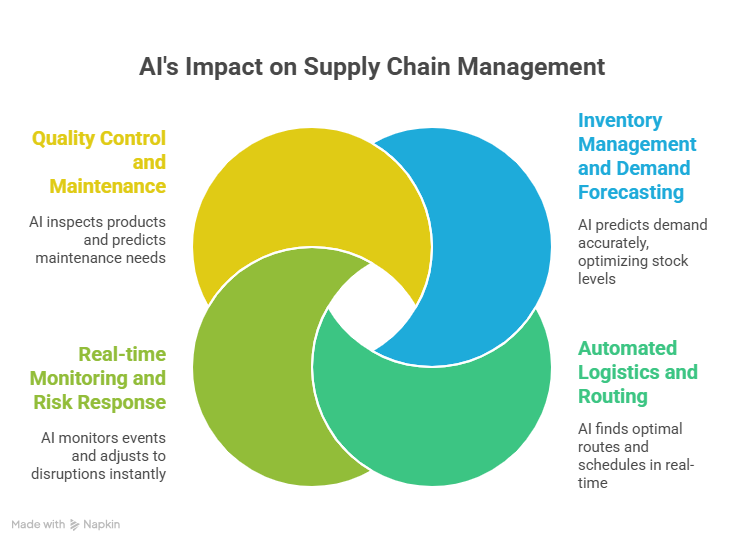
2.4 Optimize Human Resources and Recruitment
The Human Resources (HR) function is another area ripe for AI-driven automation. From recruiting the right talent to managing employee development, AI tools are helping HR teams save time and make better decisions:
- Recruitment Automation: Reading through hundreds of resumes or LinkedIn profiles for a job opening can be extremely time-consuming. AI-powered recruitment platforms can automatically screen resumes, filter out unqualified candidates, and even conduct initial text-based interviews with chatbots. This can cut the hiring process time significantly. In fact, 86% of recruiters using AI say it accelerates hiring and improves efficiency. For example, an AI might highlight the top 5% of applicants for a software engineering role based on skills and experience, so hiring managers spend time only on the best matches.
- Reducing Bias and Improving Fit: AI tools can be trained to ignore demographic information and focus purely on qualifications, potentially reducing human biases in hiring. They can also analyze which employee characteristics have correlated with success at a company historically and use that to score candidates, improving quality-of-hire. Of course, it’s important to monitor these systems to ensure new biases aren’t introduced via the training data – but when done right, AI can support fairer, more merit-based hiring.
- Onboarding and Training: Once new employees are hired, AI-driven platforms can automate parts of onboarding – answering common new hire questions through a chatbot, or customizing a training plan based on the role. AI can schedule orientation sessions, send reminders to complete paperwork, and be a 24/7 helpdesk for questions like “How do I set up my email on my phone?”
- HR Service and Support: Inside the company, employees often have HR-related queries (benefits, policies, leave balances, etc.). AI chatbots serve as always-available HR assistants to field these routine inquiries, providing instant answers and reducing the load on HR staff. This is similar to customer service chatbots, except your “customers” are your employees.
- Retention and Employee Insights: Some AI tools analyze employee engagement survey data or even email communication patterns (with appropriate privacy safeguards) to gauge morale and identify who might be at risk of leaving. This allows HR to proactively address issues or intervene to retain valued staff. Predictive analytics can alert HR, for instance, that certain teams are showing signs of burnout or disengagement, prompting action before resignations happen.
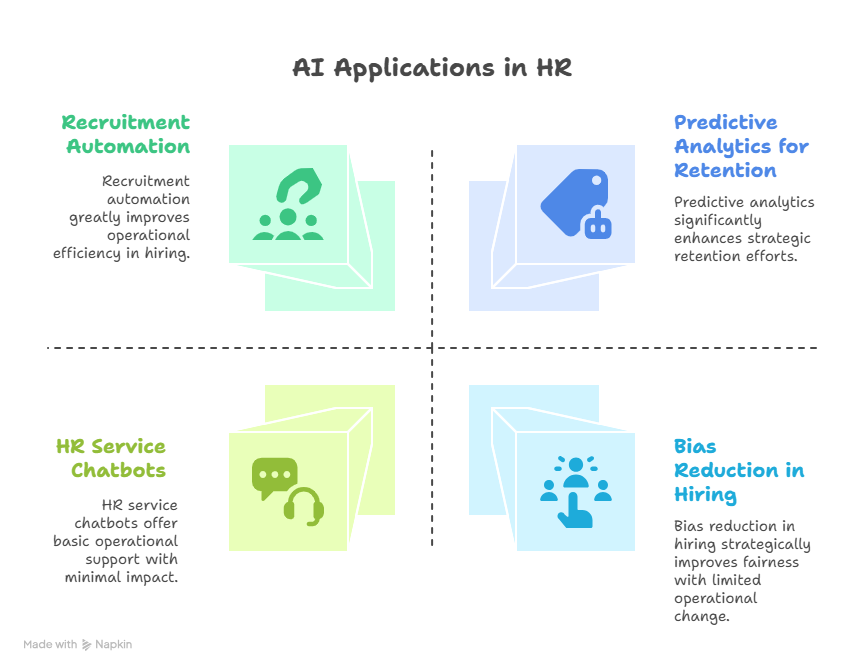
Real-world impact: Companies that use AI in HR report major time savings. 85% of employers who use AI for HR say it saves them time and increases efficiency in managing people processes. For example, global firm Unilever famously uses AI interviews and gamified assessments to winnow down thousands of early-career applicants, cutting recruiter screening work by 75% and improving diversity in candidates selected. Another case: an international call center used an AI scheduling tool to optimize shifts based on agent performance and preferences, resulting in a 20% efficiency gain in staffing and a happier workforce. The message is clear – by automating administrative burdens and providing data-driven insights, AI empowers HR teams to focus on building culture and talent strategy rather than drowning in paperwork.
2.5 Strengthen Finance with AI-Powered Fraud Detection and Analytics
Finance and accounting departments benefit enormously from AI automation, which can increase accuracy and security while reducing manual drudgery:
- Automating Transaction Processing: AI systems (often in the form of robotic process automation enhanced with AI) can handle routine finance tasks – processing invoices, reconciling accounts, generating expense reports – much faster than humans and with fewer errors. This means monthly closes and financial reports can be produced with less crunch-time stress, and finance staff can spend more time on analysis rather than data entry.
- Real-Time Fraud Detection: Perhaps the biggest impact of AI in finance is in fraud detection and risk management. AI can monitor financial transactions in real time, flagging anomalies that might indicate fraud or errors. Importantly, AI models can learn from patterns, catching new types of fraud that rule-based systems might miss. It’s telling that 91% of U.S. banks now use AI for fraud detection – it’s become a cornerstone of modern financial security. These AI systems scour through millions of transactions looking for outliers (like an unusual transfer, or a sequence of activities that fits a money-laundering pattern) and raise red flags instantly for further investigation.
- Expense Management and Cost Control: AI can also help companies save money by analyzing spending patterns and highlighting waste or unusual expenditures. For instance, an AI might detect that one vendor is consistently charging higher rates than others for similar purchases, suggesting an opportunity to renegotiate a contract. Or it could identify duplicate payments, errors in travel expense claims, etc., that humans overlooked. Machine learning improves fraud and error detection accuracy by up to 90% in banking transactions according to studies, which translates to catching more misuse of funds internally as well.
- Cash Flow Forecasting and Decision Support: By analyzing historical cash flows, sales forecasts, and economic indicators, AI tools can help predict future cash flows and liquidity needs for the business. This aids in better treasury management – companies know when they might need short-term financing or when they’ll have surplus cash to invest. Similarly, AI can optimize portfolio management for financial institutions or even suggest optimal budgeting allocations for departments based on performance data.
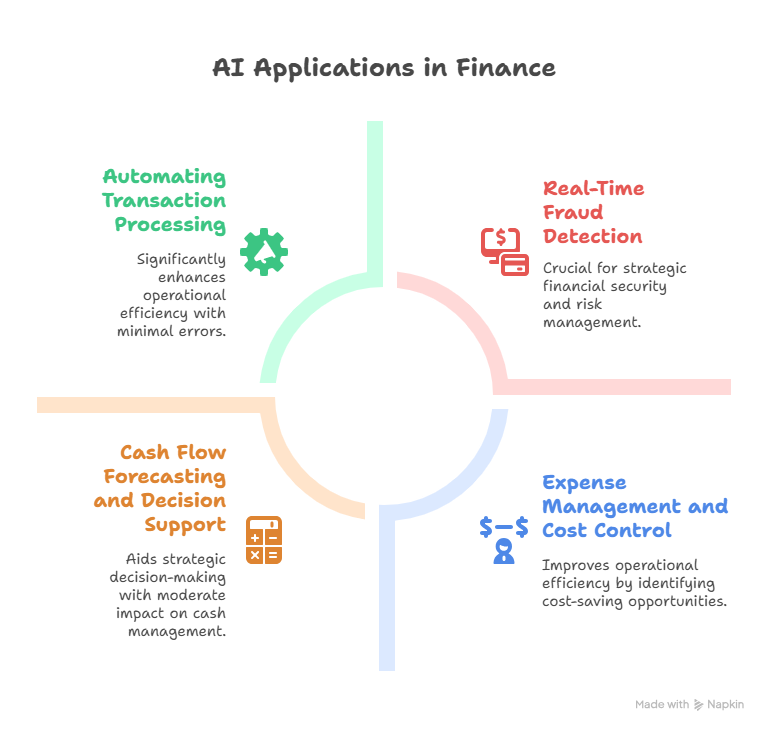
Real-world example: The U.S. Department of the Treasury implemented an AI-enhanced system to detect fraudulent pandemic relief claims, which recovered over $375 million that might otherwise have been lost. On the corporate side, Mastercard deployed AI algorithms for transaction monitoring and saw a dramatic reduction in false positives (legitimate transactions mistakenly flagged) while catching more fraudulent ones – saving millions in potential fraud losses. Another example: a European bank used AI to automate their accounts payable processing; within a year, they cut invoice processing costs by 30% and virtually eliminated late payment penalties. These successes underscore that AI doesn’t just make finance operations faster – it makes them smarter and more secure.
2.6 Accelerate Data Analysis and Decision-Making
Every business today is awash in data, but raw data alone doesn’t drive value – timely insights and decisions do. AI is increasingly the engine turning data into actionable intelligence, at a speed and scale far beyond human capabilities:
- Big Data Crunching: AI analytic tools can ingest vast amounts of data in real time, whether it’s sales figures, website clicks, sensor readings, or social media trends. They then find patterns, correlations, and anomalies that would be invisible to the naked eye. This not only saves analysts countless hours of number-crunching, it also often reveals surprising insights. For example, an AI system might discover that a certain weather pattern sharply boosts demand for one of your products, leading you to adjust marketing spend in those conditions.
- Predictive Analytics: Beyond analyzing historical data, AI excels at prediction. Machine learning models can forecast future outcomes – be it customer churn, maintenance needs (as discussed earlier), or market fluctuations. Companies using predictive analytics report improved planning and competitiveness. In fact, one study projects that AI could contribute $15.7 trillion to the global economy by 2030 largely through productivity and decision-making improvements. By anticipating trends, businesses can make proactive decisions (like a retailer stocking up the right products before a seasonal rush, guided by AI forecasts).
- Faster and Better Decisions: With AI, decision-makers can get instant insights through dashboards and alerts. Instead of waiting for end-of-month reports, managers get continuous updates and can course-correct on the fly. AI systems can also provide decision recommendations – for instance, an AI tool might suggest optimal pricing for a new service by analyzing similar product performance and customer elasticity. Ultimately, this can lead to better outcomes: a McKinsey analysis found that companies using AI-driven decision-making could increase profitability by several percentage points above those that don’t.
- Democratizing Data Access: AI-powered business intelligence (BI) tools allow non-technical users to ask questions in plain English and get answers from the data. This “augmented analytics” approach means someone in marketing could ask, “Which customer segment grew the fastest last quarter and why?” and the AI might respond with a natural language report and visualizations pulled from the data. By automating analysis and interpretation, AI makes advanced analytics accessible across the organization, not just to data scientists.
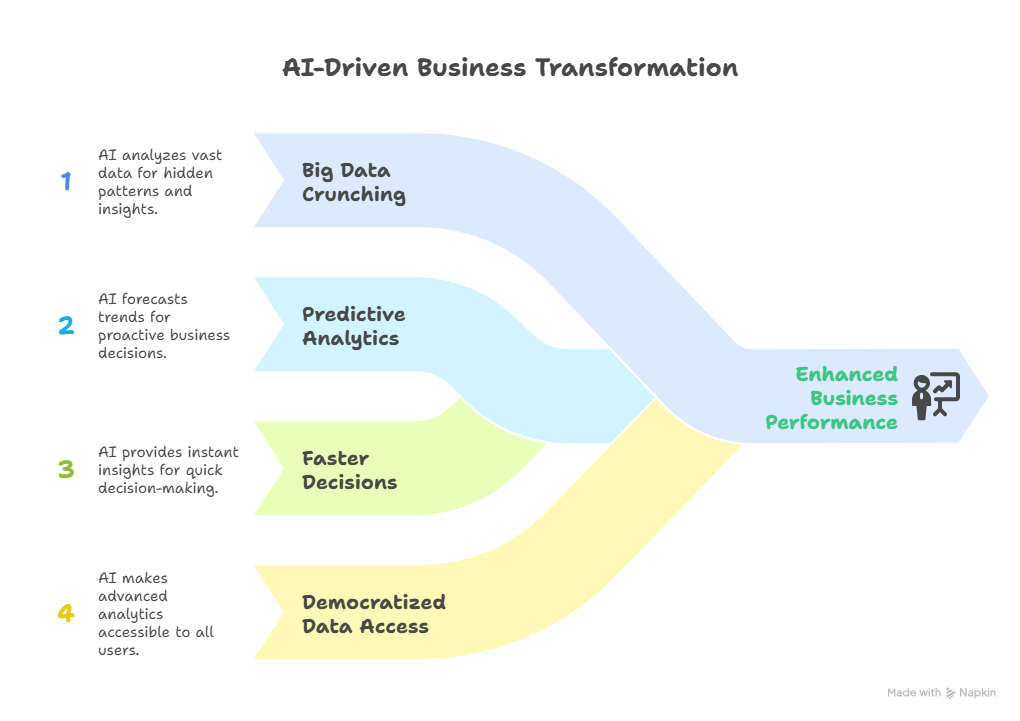
Real-world example: Global consumer goods company Procter & Gamble implemented an AI-driven analytics platform that pulls in data from sources like social media, sales, and Google searches. In one case, it spotted an emerging trend for hand sanitizer 8 days before sales spiked early in the pandemic, allowing P&G to ramp up production and capture an estimated $200+ million in additional sales. Another example: many investment firms use AI algorithms to analyze market data and news feeds; these systems can execute trades in milliseconds based on complex strategies, something human traders cannot do at scale. Even small businesses benefit – for instance, a chain of restaurants used an AI tool to analyze point-of-sale data combined with local events and weather, enabling each outlet to automatically adjust staffing and inventory for the day, cutting food waste by 20% and reducing labor costs with no hit to service. In summary, AI-driven analysis is like giving your company a superpower: the ability to know more and act faster than the competition.
2.7 Transform Training and E-Learning with AI
Employee training and development is crucial but can be labor-intensive to create and deliver. AI is changing that by making corporate learning more personalized, interactive, and efficient:
- Personalized Learning Paths: AI can assess an employee’s current knowledge and skills (through quizzes, interactions, even analysis of work outputs) and then tailor training content to that individual. If a new hire is already proficient in Topic A but weak in Topic B, an AI-driven platform will focus their training on Topic B to efficiently close the gap. This ensures employees aren’t bored with stuff they know or overwhelmed with content that’s too advanced. It’s a Netflix-style approach to learning, where the platform recommends the next module or exercise based on your history and performance. Research shows personalized e-learning can significantly improve retention and engagement, because it respects each learner’s pace and needs.
- Content Creation and Curation: One of the hardest parts of training is developing the materials – slides, reading content, quizzes, videos, etc. AI is now capable of generating draft training content from source materials. For example, if you give an AI an internal policy document, it could generate a summary slide deck or even a set of quiz questions about that policy. This automates the content authoring process, saving learning & development teams huge amounts of time. Some advanced platforms (including solutions we’ll mention later) can take various inputs – PDFs, PowerPoints, even video transcripts – and produce a structured course out of them, complete with learning objectives and knowledge checks.
- Virtual Coaching and Feedback: AI-based virtual coaches can simulate role-play scenarios for soft skills training. For instance, a sales rep could practice a pitch with an AI that listens and then provides feedback on their speaking pace, filler words, or how well they addressed customer concerns. AI tutors are also used in technical fields to help employees practice coding or troubleshooting problems, giving hints when they get stuck. These on-demand coaches make practice possible anytime, not just in scheduled workshops.
- Adaptive Assessment: Testing and assessment are also improved by AI. Instead of a one-size-fits-all exam, adaptive assessment adjusts difficulty based on the test-taker’s responses (similar to the GRE or GMAT tests). This quickly zeroes in on the person’s proficiency level. AI can also automate grading of free-response answers by using natural language processing to evaluate the content of an answer (particularly useful for things like short essay responses or technical explanations). Immediate feedback can then be given, which helps reinforce learning.
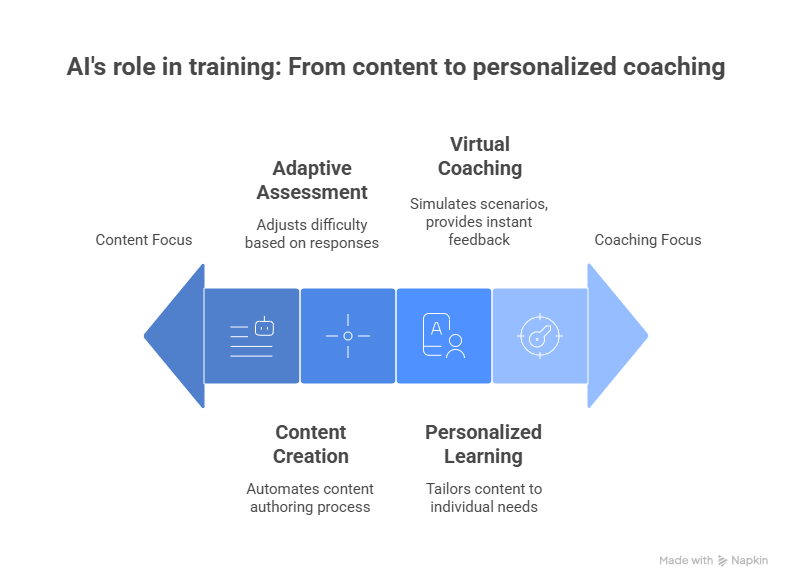
Real-world example: International bank Citi built an AI-powered compliance training that adapts to employees’ roles and prior knowledge. They found that completion rates and satisfaction scores went up significantly because irrelevant content was trimmed out for each learner. Another example is telecom company Verizon, which used AI to auto-generate training modules for new retail store employees by ingesting their product manuals and internal wikis – this cut down course development time by roughly 50% and ensured training was always up-to-date. Even in manufacturing, companies are using AR (augmented reality) combined with AI, where a worker can wear smart glasses and get real-time guidance from an AI assistant while doing a procedure, effectively training on the job with AI support. The common result across these cases: employees learn faster and better, and training programs become more scalable and responsive to change, thanks to AI.
2.8 Improve Internal Knowledge Management and Decision Support
How many times have you or your employees spent hours searching for a piece of information hidden in emails, documents, or intranet pages? If that sounds familiar, you’re not alone – studies show the average employee spends up to 2 hours per day searching for information or recreating content that already exists. AI-driven knowledge management systems are here to solve this by acting as intelligent librarians for your organization’s knowledge:
- Centralized Knowledge Hubs with AI Search: Modern AI knowledge platforms integrate with your internal data sources – SharePoint, Google Drive, wikis, CRM, you name it – and index all the content. They use natural language processing to understand context. So when an employee has a question like “How do I handle a return for a custom order?” they can ask an AI assistant, which will instantly retrieve the exact policy or a snippet from a manual that answers the question. This is vastly quicker than manually digging through folders or emailing coworkers for help.
- Smart Q&A and Troubleshooting: These AI systems can also act like a “Stack Overflow” for the company, where they learn from past Q&As. If someone asks “How do I configure Project X software?”, and that question had been answered before (in an email or forum), the AI can provide the previous answer – or even combine information from multiple sources to give a comprehensive solution. Over time, as employees ask more, the AI becomes a richer answer database. Some companies deploy chatbots internally so employees can just message a bot to get answers for IT support issues or HR policy questions, instead of opening tickets for every little thing.
- Preemptive Knowledge Delivery: AI can also push relevant information to employees before they even search. For instance, if there’s a new procedure and an employee schedules a meeting about a related topic, an AI might proactively suggest, “Hey, here’s the latest guideline on that process.” Or a salesperson about to go into a client meeting might get a briefing generated from internal databases about the client’s recent orders, support tickets, and product usage – all compiled automatically.
- Maintaining Up-to-Date Content: One challenge with any knowledge base is keeping it current. AI can help by detecting redundant or outdated documents and either archiving them or even suggesting updates by comparing with newer data. Some AI tools will notify content owners if, say, a procedure hasn’t been updated in 2 years and there’s indication (from new regulations or product changes) that it might be stale. This helps reduce the clutter of old info and ensures people are finding current answers. A centralized, AI-curated knowledge hub also cuts down on duplicate documents (how many versions of “Project Plan Template” do you really need floating around?). By eliminating duplicates and consolidating information, employees gain a single source of truth, which improves decision-making quality.
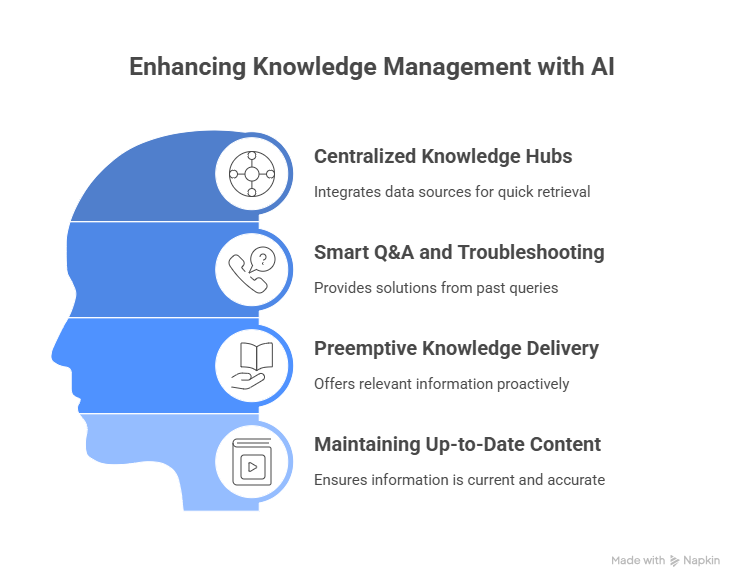
Real-world example: An international consulting firm deployed an AI knowledge management system to support its thousands of consultants. It connected to all past project reports, proposals, research subscriptions, etc. Now when consultants need to quickly gather insight on, say, “pharmaceutical supply chain best practices,” they can query the AI and get a curated summary pulling from various internal and external documents. This not only saved time (the firm estimated each consultant saved about 5-8 hours per week on information search), but also improved work quality by ensuring everyone was using the firm’s collective knowledge. Another example: our own AI4Knowledge platform (discussed below) has helped clients reduce internal search time dramatically – recall that 2 hours per day stat, which translates to hundreds of hours a year per employee. By cutting that down, AI knowledge systems liberate employees to focus on actually using information to make decisions, rather than spending time finding information. In essence, AI turns your company’s accumulated data and documents into actionable answers and insights on demand, boosting productivity and enabling smarter decisions at all levels.
3. Making the Leap: How to Implement AI Automation Successfully
Adopting AI to automate parts of your business is a strategic move that requires planning and a thoughtful approach. As with any transformative change, there are challenges to navigate – but the rewards are well worth it. Here we provide some guidance on how to get started and maximize your chances of success.
3.1 Start Small, Learn Fast, and Scale Up Gradually
One key to success is to begin with focused pilot projects rather than a big bang overhaul. Identify a few high-impact, manageable processes that are good candidates for AI automation. It could be something like automating your customer FAQ responses, or using AI to vet job applicants up to a certain stage, or optimizing inventory reorders with a machine learning model. Early wins build confidence and create organizational buy-in for broader AI initiatives.
- Proof of Concept (PoC): Treat the first implementation as a learning opportunity. Set clear metrics for success (e.g., reduce support response time by X%, increase lead conversion by Y%, or cut processing cost by Z dollars) and measure the results. This will help you refine the technology and also make a business case for expanding AI elsewhere. It’s common that initial AI projects might not hit a home run immediately – the algorithms might need tuning, or the data quality might need improvement – which is all fine as long as you iterate and improve.
- Incremental Integration: Once a pilot is successful, expand its scope or replicate its approach in other areas. For example, after a successful chatbot for customer service, you might introduce a similar AI assistant for internal IT support. Or after automating invoice processing in finance, you target automating purchase order approvals next. By phasing the rollout, employees and systems have time to adapt, and you minimize disruption. Remember that only about 26% of companies have fully scaled AI initiatives company-wide to get significant value – most are still in experimental or limited deployment phases. Breaking into that elite group requires a deliberate scaling strategy after initial success.
- Data and Infrastructure Prep: Early on, ensure you have the data infrastructure in place. AI thrives on data – so invest in consolidating your databases, cleaning data, and perhaps establishing a data warehouse or data lake that can serve as the “single source of truth” for AI systems. Small projects can often be done with standalone datasets, but scaling up will eventually require a robust data pipeline. Cloud platforms (AWS, Azure, Google Cloud) offer great tools to support AI deployments, and starting pilots on cloud can make it easier to scale later without a huge capital investment in hardware.
- Manage Expectations: It’s worth noting that AI is not magic. Some tasks will prove harder to automate than others, and it’s important to communicate that patience is needed. Stakeholders should understand that AI projects might take a few iterations to get right. The payoff can be huge, but unrealistic expectations can lead to disappointment. Instead, celebrate the gradual improvements. For instance, maybe your first chatbot could only handle 30% of inquiries without human help – but after training on more data, it handled 50%, and in a year, 80%. Each step is a win. As one expert puts it, successful AI implementation is “a journey, not a sprint,” and the most important thing is to keep moving forward and learning along the way.
3.2 Invest in Skills, Culture, and Continuous Improvement
Technology alone doesn’t guarantee success – it’s how people and processes adapt alongside the technology that truly determines outcomes. To fully harness AI for automation, companies need to invest in their teams and cultivate a culture that embraces data-driven innovation:
- Upskilling Your Team: Employees may worry about what AI means for their jobs. The reality, as we’ve discussed, is that AI often automates parts of roles, not entire positions. But it does change job profiles. Companies leading in AI make significant efforts to train their workforce on new skills. This might include formal programs to learn data analysis, AI tool usage, or simply how to interpret AI-generated insights. Even non-technical roles benefit from a basic understanding of AI capabilities and limitations. A well-known statistic from the World Economic Forum predicted that by 2025 AI would create more jobs than it displaces – roughly 97 million new AI-related roles versus 85 million roles changed or eliminated. The new jobs will be different, requiring more digital and analytical know-how. Forward-thinking organizations are preparing their people for these roles now. For example, banks retraining tellers to become “digital ambassadors” or analysts who work alongside AI fraud detectors.
- Change Management and Communication: Introducing AI might change processes that have been done manually for years. It’s crucial to explain the why to those affected. Involve end-users early – get input from the customer service reps when deploying a support chatbot; involve finance clerks when rolling out invoice processing AI. This not only helps design a better solution (because you incorporate frontline expertise), it also helps employees feel part of the change rather than victims of it. Celebrate successes and recognize teams that adopt the AI tools effectively. Often, once people see an AI system taking away the drudgery of their job, they become its biggest fans – but initial apprehension is natural and must be addressed with empathy and training.
- Data Culture: Encourage a culture of making decisions based on data and AI insights. This might mean updating dashboards, KPIs, and meeting routines to include AI findings. For instance, a sales team meeting might start including a segment where they review what the lead-scoring AI is saying about the pipeline, and discuss where to focus – rather than purely going on gut or anecdotal input. Over time, as people see the AI recommendations translating to good results, trust builds. However, maintaining human oversight is important – AI can occasionally be wrong or biased, so a healthy practice is to validate AI outputs, especially early on. Make it clear that AI is a tool to augment human judgment, not replace it entirely. This balanced view helps prevent over-reliance on the tech without understanding.
- Continuous Monitoring and Iteration: AI models can drift in performance over time if the environment changes. Have a plan to continuously monitor the results of your AI automations and recalibrate as needed. Perhaps schedule quarterly reviews of key metrics: is the customer chatbot still maintaining high resolution rates? Is the fraud detection AI generating too many false alarms suddenly (maybe because fraudsters adapted)? Many AI platforms provide monitoring dashboards; use them. Consider an “AI audit” practice – periodically have a data science team or an external expert review the algorithms for accuracy, fairness, and effectiveness. This ongoing care-and-feeding ensures you sustain and amplify the benefits long-term. Companies that treat AI implementation as a one-and-done install often see performance plateau or even degrade. In contrast, companies that take an agile, continuous improvement approach (tweak model parameters, feed in new training data, extend the model’s scope, etc.) continue to increase value from AI over time.
- Stay Informed and Experiment: The AI field is evolving rapidly. New techniques and tools emerge almost every month (just think of the explosion in generative AI tools recently). Leading organizations foster an environment where small experiments with new AI tech are encouraged. Maybe your R&D department plays around with an AI code generator to see if it can help in software prototyping. Or your marketing team pilots a generative AI to draft social media posts. Not every experiment will pan out, but this keeps your organization on the cutting edge. Remember, 92% of businesses are considering investing in new AI software as of 2024 – your competitors are likely among them. Keeping up with AI advancements, and being willing to adapt your automation strategies as tech improves, will help you maintain a competitive edge.
In conclusion, implementing AI to automate your business is a marathon, not a sprint. Start with a strong strategy, involve your people, and foster a mindset of learning and adaptation. The companies that do this are already seeing substantial gains, and they’re positioning themselves to dominate in an AI-driven future. The sooner you begin this journey, the sooner you can harvest the efficiencies and innovations AI has to offer.

4. TTMS AI Solutions – Automate Your Business with Expert Help
Embracing AI for automation can be transformative, but you don’t have to do it alone. Transition Technologies MS (TTMS) specializes in delivering AI-driven solutions that help businesses automate processes intelligently and effectively. We have a proven track record of implementing AI across various industries – from finance and legal to education and IT – and we’re ready to assist your organization on its automation journey. Below are some of our flagship AI products and services that can jump-start your automation efforts:
- AI4Legal – Intelligent Automation for Law Firms: AI4Legal is our advanced solution designed for legal professionals, automating time-consuming tasks like analyzing court documents, generating draft contracts, and processing case transcripts. By leveraging technologies such as Azure OpenAI and Llama, AI4Legal helps law firms quickly review large volumes of case files and even create summaries or first-draft pleadings with ease. The system eliminates manual drudgery and human error in document review, allowing lawyers to focus on complex legal analysis and client interaction. Whether you’re a small practice or a large legal department, AI4Legal can significantly boost your efficiency and productivity while maintaining high accuracy and data security standards.
- AI4Content – AI Document Analysis Tool: Every business deals with documents – reports, forms, research papers, etc. Our AI4Content tool acts as an AI document analyst that can automatically process and summarize various types of documents in minutes. It’s like having a tireless assistant that reads and distills documents for you. You can feed it PDFs, Word files, spreadsheets – even audio transcripts – and get back structured summaries or reports tailored to your needs. AI4Content is highly customizable; you can define the format and components of the output to fit your internal reporting standards. Crucially, it’s built with enterprise-grade security, so your sensitive data stays protected throughout the analysis process. This tool is ideal for industries like finance (to summarize analyst reports), pharma (to extract insights from research articles), or any field where critical information is hidden in lengthy texts – AI4Content will surface the insights in a fraction of the time it takes humans.
- AI4E-Learning – AI-Powered E-Learning Authoring: If you have training content to produce, AI4E-learning can revolutionize that process. This AI-driven platform takes your existing materials (documents, presentations, audio, video) and rapidly generates professional training courses out of them. For instance, upload an internal policy PDF and a recorded lecture, and AI4E-learning will create a structured e-learning module complete with key takeaways, quiz questions, and even instructor-led training guides. It’s a huge time-saver for HR and L&D departments. The content can be easily edited and personalized via an intuitive interface, so you remain in control of the final output. Companies using AI4E-learning find they can develop employee training programs much faster without sacrificing quality – all while ensuring the content stays consistent with their internal knowledge base and branding.
- AI4Knowledge – AI-Based Knowledge Management System: AI4Knowledge is our intelligent knowledge hub that ensures everyone in your organization can access information when they need it. It acts as a central repository for procedures, manuals, and best practices, equipped with a natural language search interface. Instead of digging through intranet pages, employees can ask the system questions and get clear, step-by-step answers drawn from your company’s documentation. This platform drastically reduces time spent searching for information (recall that average of 2 hours a day wasted – AI4Knowledge gives that time back). Features include advanced indexing (to connect related info), duplicate removal, and automatic content updates, so your knowledge base stays clean and up-to-date. Whether it’s a new hire looking up how to perform a task, or a manager needing a quick refresher on policy, AI4Knowledge provides instant support, leading to faster decision-making and fewer errors in execution.
- AI4Localisation – AI Content Localization Services: For businesses operating across multiple languages and markets, AI4Localisation is a game-changer. This is our AI-powered translation and localization platform that produces fast, context-aware translations tailored to your industry. It goes beyond basic machine translation by allowing customization for tone, style, and terminology – ensuring the translated content reads as if crafted by a local expert. AI4Localisation supports 30+ languages and can even handle simultaneous multi-language translation projects. With built-in quality assessment tools, you get a quality score and suggestions for any post-editing, although the output is often publication-ready. Companies using AI4Localisation have achieved up to 70% faster translation turnarounds for their documents and marketing materials. From websites and product manuals to elearning content (integrating nicely with AI4E-learning) – this service helps you speak your customer’s language without the usual delays and costs.
- AML Track – Automated Anti-Money Laundering Compliance: Compliance automation is a pressing need, especially in finance, legal, and other regulated sectors. AML Track is an advanced AI compliance platform (developed by TTMS in partnership with the law firm Sawaryn & Partners) designed to automate key anti-money laundering (AML) processes. This solution automates customer due diligence, real-time transaction monitoring, sanctions and PEP list screening, and generates audit-ready AML reports – all in one integrated system. In practice, AML Track will automatically pull data from public registers (e.g. company registries), verify client identities, check if any client or counterparty appears on various international sanctions or politically exposed persons (PEP) lists, and continuously monitor transactions for suspicious patterns. It then compiles findings into comprehensive reports to satisfy regulatory requirements, eliminating the need for manual cross-checking of multiple databases. The platform is kept up-to-date with the latest global and local AML regulations (including the EU’s 6AMLD), so your business stays compliant by default. By centralizing and automating AML compliance, AML Track reduces human error, speeds up compliance procedures, and minimizes your risk of regulatory fines. It’s a scalable solution suitable for banks, fintech startups, insurance companies, real estate firms, or any institution deemed an “obliged entity” under AML laws. In short, AML Track lets you stay ahead of financial crime risks while significantly cutting the effort and cost of compliance.
Each of these TTMS AI solutions is backed by our team of experts who will work closely with you from planning to deployment. We understand that successful AI integration requires more than just software – it takes aligning with your business goals, integrating with your existing systems, and training your people to get the most out of the tools. Our approach emphasizes collaboration and customization: we tailor our platforms to your unique needs and ensure a smooth change management process.

Ready to Automate? Whether you’re just starting to explore AI or looking to scale your AI initiatives further, TTMS can provide the guidance and technology you need. By choosing us as your partner, you’ll leverage over a decade of experience we have in delivering secure, scalable IT solutions worldwide, and specifically our deep expertise in AI-driven transformation. The future of business is automated and intelligent – let’s get there together.
👉 Contact TTMS to discuss how our AI solutions can help automate your business processes, drive efficiency, and keep you ahead of the competition. Let’s unlock new levels of productivity and innovation with the power of AI!
What is the difference between AI automation and traditional automation tools?
Traditional automation tools usually follow fixed rules or scripts, which makes them effective only in predictable, repetitive scenarios. AI automation, on the other hand, uses machine learning, natural language processing, and predictive analytics to adapt to new inputs and changing conditions. For example, while a traditional system can send the same email when an order is shipped, an AI-powered solution can personalize the message, predict follow-up questions, and even optimize delivery routes dynamically. This flexibility makes AI automation far more powerful and future-proof.
How can small businesses use AI to automate business processes without high costs?
Small companies often assume AI is only for large corporations, but cloud-based platforms and subscription models have made it affordable and scalable. Small businesses can start with simple AI tools like chatbots for customer service, automated invoicing systems, or AI-powered marketing platforms that personalize campaigns. These entry-level solutions require minimal infrastructure and deliver quick returns, allowing smaller firms to automate essential processes without the need for expensive custom development.
hat risks should businesses consider before implementing AI automation?
While the benefits are significant, companies should also be aware of potential risks. These include data privacy concerns, algorithmic bias, over-reliance on automated decisions, and challenges in integrating AI with legacy systems. Poorly trained models may deliver inaccurate results, and employees may resist new technologies if change management is neglected. To mitigate risks, organizations should establish strong data governance, involve human oversight, and start with pilot projects that can be scaled gradually once proven effective.
How long does it typically take to see results from AI automation?
The timeline depends on the scope of the project and the complexity of processes being automated. For straightforward use cases such as customer support chatbots or automated reporting, results can be seen within weeks. More complex implementations, like predictive supply chain optimization or fraud detection systems, may take several months to deliver measurable impact. However, most businesses begin noticing efficiency gains and cost savings within the first 3–6 months after deployment, especially when the rollout is done in phases with clear success metrics.
Can AI automation replace entire jobs, or does it mainly augment existing roles?
AI automation rarely eliminates entire jobs outright; instead, it usually automates repetitive tasks within those jobs. For instance, in finance, AI can handle invoice reconciliation, but financial analysts are still needed to interpret insights and make strategic decisions. In HR, AI might screen resumes, but recruiters still conduct interviews and assess cultural fit. By reducing the time spent on low-value tasks, employees are freed to focus on innovation, problem-solving, and customer interaction. In this sense, AI acts as an augmentation tool rather than a complete replacement, enhancing human capabilities while driving productivity.
